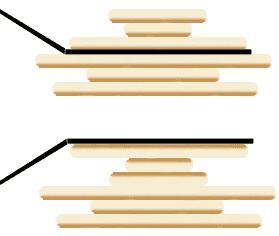 | ||
Pancake sorting is the colloquial term for the mathematical problem of sorting a disordered stack of pancakes in order of size when a spatula can be inserted at any point in the stack and used to flip all pancakes above it. A pancake number is the minimum number of flips required for a given number of pancakes. In this form, the problem was first discussed by American geometer Jacob E. Goodman. It is a variation of the sorting problem in which the only allowed operation is to reverse the elements of some prefix of the sequence. Unlike a traditional sorting algorithm, which attempts to sort with the fewest comparisons possible, the goal is to sort the sequence in as few reversals as possible. A variant of the problem is concerned with burnt pancakes, where each pancake has a burnt side and all pancakes must, in addition, end up with the burnt side on bottom.
Contents
The original pancake problem
The minimum number of flips required to sort any stack of n pancakes has been shown to lie between 15/14n and 18/11n (approximately 1.07n and 1.64n,) but the exact value is not known.
The simplest pancake sorting algorithm requires at most 2n − 3 flips. In this algorithm, a variation of selection sort, we bring the largest pancake not yet sorted to the top with one flip, and then take it down to its final position with one more, then repeat this for the remaining pancakes.
In 1979, Bill Gates and Christos Papadimitriou gave an upper bound of 5/3n. This was improved, thirty years later, to 18/11n by a team of researchers at the University of Texas at Dallas, led by Founders Professor Hal Sudborough (Chitturi et al., 2009).
The problem of determining the minimal number of moves for a given stack has been shown to be NP-hard in a paper published in 2015, thereby answering a question open for over three decades.
The burnt pancake problem
In a more difficult variation called the burnt pancake problem, the bottom of each pancake in the pile is burnt, and the sort must be completed with the burnt side of every pancake down. In 2008, a group of undergraduates built a bacterial computer that can solve a simple example of the burnt pancake problem by programming E. coli to flip segments of DNA which are analogous to burnt pancakes. DNA has an orientation (5' and 3') and an order (promoter before coding). Even though the processing power expressed by DNA flips is low, the high number of bacteria in a culture provides a large parallel computing platform. The bacteria report when they have solved the problem by becoming antibiotic resistant.
The identical pancakes stack problem
This is inspired from the way Indian bread (Roti or chapati) is cooked. Initially, all rotis are stacked in one column, and the cook uses a spatula to flip the rotis so that each side of each roti touches the base fire at some point to toast. Several variants are possible: the rotis can be considered as single-sided or two-sided, and it may be forbidden or not to toast the same side twice. This version of the problem was first explored by Arka Roychowdhury.
The pancake problem on strings
The discussion above presumes that each pancake is unique, that is, the sequence on which the prefix reversals are performed is a permutation. However, "strings" are sequences in which a symbol can repeat, and this repetition may reduce the number of prefix reversals required to sort. Chitturi and Sudborough (2010) and Hurkens et al. (2007) independently showed that the complexity of transforming a compatible string into another with the minimum number of prefix reversals is NP-hard. They also gave bounds for the same. Hurkens et al. gave an exact algorithm to sort binary and ternary strings. Chitturi (2011) proved that the complexity of transforming a compatible signed string into another with the minimum number of signed prefix reversals—the burnt pancake problem on strings—is NP-hard.
History
Although seen more often as an educational device, pancake sorting also appears in applications in parallel processor networks, in which it can provide an effective routing algorithm between processors.
The problem is notable as the topic of the only well-known mathematics paper ever written by Microsoft founder Bill Gates (as William Gates), entitled "Bounds for Sorting by Prefix Reversal". Published in 1979, it describes an efficient algorithm for pancake sorting. In addition, the most notable paper published by Futurama co-creator David X. Cohen (as David S. Cohen) concerned the burnt pancake problem. Their collaborators were Christos Papadimitriou (then at Harvard, now at Berkeley) and Manuel Blum (then at Berkeley, now at Carnegie Mellon University), respectively.
The connected problems of signed sorting by reversals and sorting by reversals were also studied more recently. Whereas efficient exact algorithms have been found for the signed sorting by reversals, the problem of sorting by reversals has been proven to be hard even to approximate to within certain constant factor, and also proven to be approximable in polynomial time to within the approximation factor 1.375.
Sequences from The Online Encyclopedia of Integer Sequences of Neil Sloane:
